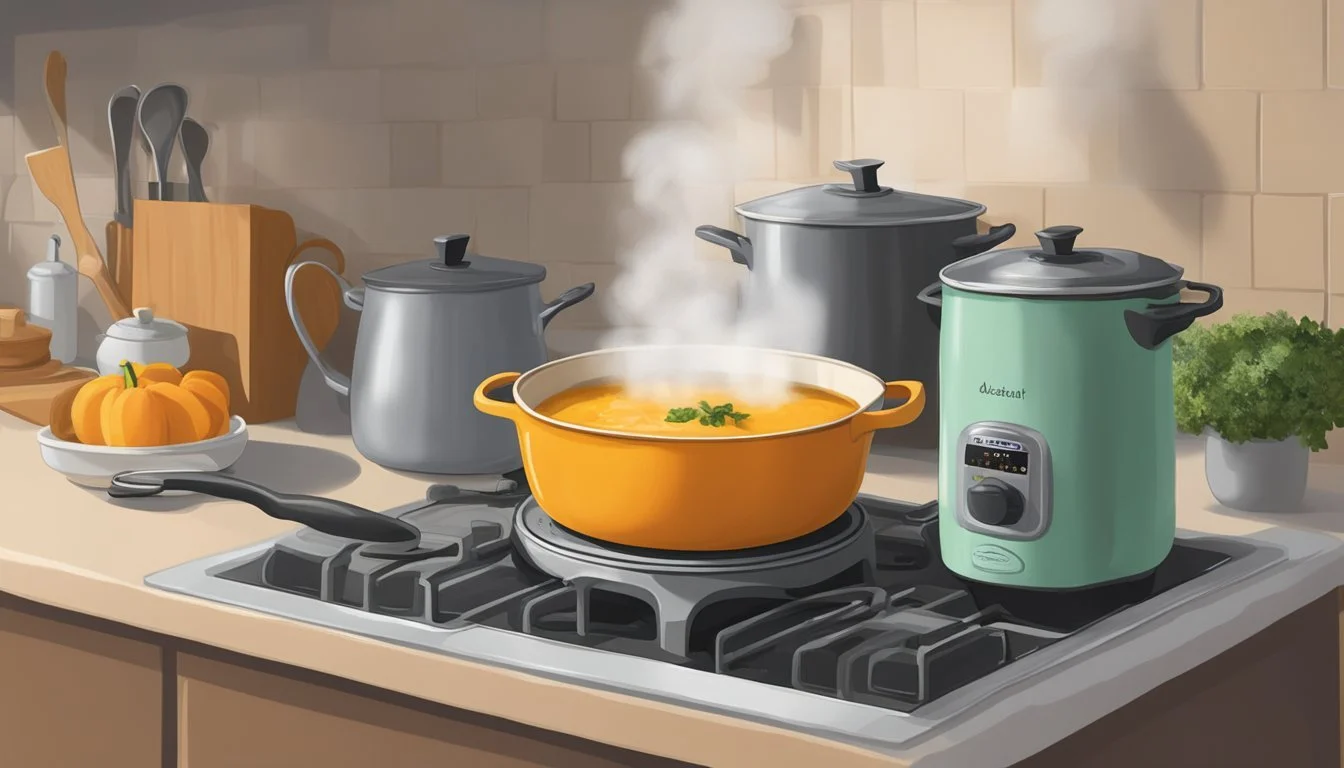How Long Does Butternut Squash Soup Last?
Preservation Tips and Shelf Life
Butternut squash soup, with its creamy texture and comforting flavor, is a favorite in many households. When stored properly in the refrigerator, butternut squash soup typically lasts for around 4 to 5 days. This period can vary slightly depending on the freshness of the ingredients and the storage conditions.
For those looking to extend the shelf life of their soup, freezing is a reliable option. Butternut squash soup can be frozen in a well-sealed container for up to three months. This allows you to enjoy its delicious and nutritious benefits even longer without compromising on quality.
Cooking and storing butternut squash soup correctly is key to maintaining its flavor and safety. Whether you prefer it fresh from the fridge or from a frozen stash, ensuring proper handling will let you savor this comforting dish for longer.
Nutritional Profile and Benefits
Butternut squash is a nutrient-rich ingredient often used in soups. It is packed with vitamins A and C, providing antioxidants that support a healthy immune system. Vitamin A, in particular, comes through in the form of beta-carotene, which is vital for vision and skin health.
A typical butternut squash soup recipe might include squash, onions, garlic, and vegetable broth. These ingredients are commonly used in vegan and vegetarian dishes. This makes butternut squash soup an excellent option for those following plant-based diets.
The macronutrient profile of butternut squash includes dietary fiber, which aids in digestion. A cup of cooked butternut squash contains:
Calories: Approximately 70-80
Protein: Around 1-2 grams
Fiber: 6-7 grams
Fat: Less than 1 gram
Its low-calorie content makes it a great option for those looking to maintain or lose weight while still enjoying a hearty meal.
Beyond the basic nutritional content, butternut squash contains potassium, which helps regulate blood pressure, and magnesium, crucial for muscle and nerve function. These micronutrients contribute to the overall health benefits of the soup.
Finally, butternut squash is also a good source of vitamin E and folate, contributing to skin health and DNA synthesis, respectively. This makes it not only a tasty addition to meals but also a healthy choice supporting diverse body functions.
Essential Ingredients and Variations
Creating a delightful butternut squash soup involves using key ingredients and exploring variations that enhance its flavor, texture, and overall appeal. Below are important elements and ways to modify the recipe for a variety of tastes and dietary needs.
Base Ingredients
The fundamental components of butternut squash soup typically include oil, onion, garlic, butternut squash, and broth.
Oil (e.g., olive oil or vegetable oil) is used for sautéing.
Onion and garlic provide a savory foundation, while the butternut squash offers the main flavor.
A good quality broth (vegetable or chicken) is essential for both flavor and consistency.
Season with salt and pepper to taste.
Flavor Enhancers
Enhance the soup's flavor with a range of spices and sweeteners.
Spices such as nutmeg, cinnamon, and turmeric add warmth and depth.
For sweetness, incorporate a touch of maple syrup or honey.
Customize by adding other spices like cumin or ginger, based on preference.
Creaminess and Texture
For a creamy and smooth texture, different ingredients can be used depending on dietary requirements.
Heavy cream or half-and-half makes the soup rich and creamy.
Coconut milk provides a dairy-free and vegan alternative, adding a subtle coconut flavor.
For those avoiding dairy, nut-based creams can also be used.
Blending the soup fully or leaving some chunks can vary the consistency to preference.
Garnishes and Accompaniments
Garnishing the soup and pairing it with suitable sides can elevate the dish.
Pumpkin seeds or croutons add a delightful crunch.
A drizzle of cream or coconut milk enhances presentation.
Serve with fresh bread, salads, or sandwiches to create a complete meal.
Fresh herbs like parsley or thyme can brighten up the final dish with both flavor and color.
Preparation and Cooking Tips
Roasting butternut squash before adding it to soup enhances its flavor. Blending techniques ensure a smooth texture, and the right herbs and spices elevate the taste profile.
Roasting the Squash
To achieve a rich, caramelized flavor, start with roasted butternut squash. Preheat the oven to 400°F (200°C). Cut the squash into even, 1-inch cubes. Toss them in olive oil and spread them on a baking sheet in a single layer.
Sprinkle with salt and black pepper, and add two to three sprigs of fresh thyme or dried thyme for added aroma. Roast for about 25-30 minutes, or until the squash is tender and lightly browned, flipping halfway through. Roasting brings out the natural sweetness and adds depth to the soup.
Blending for Smoothness
A crucial step in making butternut squash soup is achieving a smooth consistency. Use a high-powered blender or an immersion blender. If using a standard blender, work in batches to avoid overfilling and potential burns from hot liquid.
Blend the roasted squash with the broth until the soup is a smooth, thick puree. If using an immersion blender, blend directly in the pot with slow, circular motions until the desired texture is achieved. Adding a splash of heavy cream during blending can create an extra creamy finish.
Herbs and Spices
The right combination of herbs and spices elevates butternut squash soup. Classic choices include thyme and sage for their earthy notes. To add a little heat, consider a pinch of cayenne pepper. Ginger and curry powder bring warmth and complexity.
Start with about 1 teaspoon of each spice and adjust to taste. A final grind of black pepper before serving enhances the flavors. Experiment with different combinations to suit your palate, but keep the balance to ensure that the spices complement rather than overpower the sweetness of the squash.
Storing Butternut Squash Soup
Properly storing butternut squash soup can significantly extend its shelf life, ensuring it stays fresh and safe to eat. Following guidelines for refrigeration and freezing will help maintain its flavor and quality.
Refrigeration Guidelines
When storing butternut squash soup in the fridge, place it in an airtight container to prevent contamination and maintain freshness. The soup typically lasts 4 to 6 days in the refrigerator when stored correctly. It’s crucial to refrigerate the soup within two hours of cooking to avoid bacteria growth.
The temperature in your refrigerator should be maintained at 40°F (4°C) or lower. Labeling the container with the date can help track its freshness. Avoid leaving the soup at room temperature for extended periods, as this can lead to spoilage.
Freezing for Longevity
For extended storage, freezing is an effective method. Pour the soup into freezer-safe containers or freezer bags, leaving some space at the top to allow for expansion as it freezes. It’s advisable to measure and portion the soup beforehand for convenience.
Frozen butternut squash soup can last up to 3 months in the freezer. Before reheating, it’s best to thaw the soup in the refrigerator overnight. Avoid refreezing thawed soup, as this may affect its quality and safety. Using these practices ensures your soup remains flavorful and ready to enjoy for months.
Checking Soup Quality Before Consumption
Ensuring butternut squash soup is safe to eat involves assessing both its appearance and taste, as well as considering various safety measures after storage. These factors minimize the risk of consuming spoiled soup.
Visual and Taste Indicators
When evaluating butternut squash soup, check for any visible signs of spoilage. Mold growth on the surface is a clear indicator that the soup should be discarded. Another visual cue is a separation of the soup’s components, which could suggest that it has gone bad.
Smell the soup for any off or unpleasant odors. A sour or unusual smell often signals spoilage. Taste a small spoonful if it looks and smells fine. A sour or spicy flavor not typical of the soup's normal taste can indicate that it is no longer safe to consume.
Safety Measures After Storing
Temperature management is critical for maintaining soup quality. Always store butternut squash soup in an airtight container and place it in the refrigerator at or below 40°F (4°C). If stored in the freezer, ensure it's kept at 0°F (-18°C) or lower, labeled with a date, and consumed within three months.
When reheating the soup, bring it to a rolling boil to eliminate any potential bacteria. Avoid reheating multiple times, as each cycle increases the risk of the soup going bad. Smell the soup again after reheating to ensure it has not developed any unpleasant odors indicating spoilage.
Serving Suggestions
Butternut squash soup can be paired with various sides and garnishes to create a cozy and complete meal. Whether you're looking for ideal complements or tips on presentation, this section will provide specific advice to elevate your dining experience.
Ideal Complements
Dinner Rolls and Bread: Serving the soup with dinner rolls or crusty bread is a perfect match. The soft, warm bread complements the creamy texture of the soup.
Salads: A fresh salad, such as a mixed greens or arugula salad tossed with a light vinaigrette, pairs well by adding a refreshing contrast to the soup.
Sandwiches: Grilled cheese sandwiches or paninis with avocado make a hearty side that enhances the comfort of the meal.
Toppings and Garnishes: Roasted butternut squash cubes, crispy bacon bits, toasted pumpkin seeds, or a drizzle of balsamic syrup add depth and variety to each spoonful.
Side Dishes: Quick and easy to make, side dishes like roasted vegetables or a simple side of steamed greens offer a balanced meal option.
Presentation Tips
Color Contrast: Use garnishes like fresh herbs, such as parsley or chives, to add a pop of color. The green contrasts nicely with the soup's orange hue.
Bowls and Dishes: Serve the soup in colorful bowls to enhance its appeal. Using white or neutral-toned dinnerware can also highlight the soup's vibrant color.
Layered Toppings: Arrange garnishes in layers. For example, place a dollop of sour cream or crème fraîche in the center, then sprinkle chopped bacon or pumpkin seeds around it.
Serving Temperature: Ensure the soup is served hot for optimal flavor. If transporting, use insulated containers to maintain its warmth.
Texture Addition: Add crunch with a few croutons or toasted bread slices on the side. This contrast in texture makes for an engaging eating experience.
Common Questions and Troubleshooting
In this section, learn how to adjust soup thickness, best practices for reheating, and possible ingredient substitutions for butternut squash soup to ensure it remains delicious and safe to eat.
Soup Thickness Adjustments
To achieve the desired consistency, there are several methods you can use.
If the soup is too thick, adding a bit more broth or stock can help. Use vegetable broth, chicken stock, or even water to thin it out.
For soups that are too thin, you might consider adding cornstarch. Mix one tablespoon of cornstarch with a little cold water until smooth and add it to the boiling soup, stirring constantly. Cream or coconut milk can also be employed for added thickness and a creamier texture.
Cook until the mixture reaches the desired consistency.
Reheating Best Practices
Proper reheating ensures the soup remains safe and palatable.
For stove reheating, place the soup in a soup pot and heat it gradually over medium heat, stirring occasionally to prevent burning. Ensure it reaches a temperature of at least 165°F.
For microwave reheating, transfer the soup to a microwave-safe container and heat in one-minute intervals, stirring between each interval until thoroughly heated.
Whether using the stove or microwave, avoid frequent reheating as it can degrade the soup’s quality.
Ingredient Substitutions
Sometimes you may not have all the traditional ingredients on hand.
If you’re out of cream, use coconut milk for a different but delicious flavor profile. Chicken broth or vegetable stock can replace water for a deeper taste. When broth is unavailable, a vegetable broth cube dissolved in water is a good alternative.
Olive oil can be a good substitute for butter when sautéing vegetables to start the soup.
These substitutions allow for flexibility without compromising flavor.









